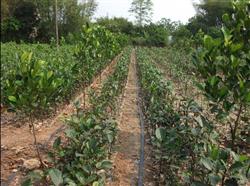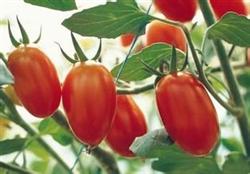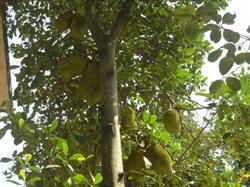Characteristics and Seedling raising techniques of Tree Pineapple

Tree pineapple, also known as wood pineapple, jackfruit, is a little-known tropical fruit, which is only sporadically distributed in the tropical and subtropical regions of China. Native to western India. Guangdong has sporadic distribution in all cities and counties south of Guangzhou, with more Dianbai and Gaozhou in the west of Guangdong and more cities and counties in Leizhou Peninsula. However, with China's reform, opening up and the development of market economy, the rational use of land resources, meteorological resources, germplasm resources and other natural resources, as fruit, grain, wood, ornamental and excellent tree species, tree pineapple has a good prospect of development; in ecologically suitable areas, large tree pineapple forest and good management will achieve significant economic and ecological benefits. First, the biological characteristics of the pineapple tree is about 10m high, with a beautiful shape, excellent ornamental wood, rich nutrition and a wide range of uses. Bark grayish brown, leaves alternate, long oval or Obovate, surface dark green, glossy, reverse yellowish green, entire, thickly papery. The flowers are unisexual aggregate flowers, the male and female inflorescences grow on the same plant at the same time, the flowers have a clear fragrance, and the flowers bloom once in summer and winter respectively. Fruit connate, oval-shaped, spindle-shaped and even long cylinder-shaped, large fruit can reach tens of kilograms. The unripe fruit is pale green, gradually yellowish green, the mature fruit is yellow or yellowish brown, the appearance is hexagonal turtle-shaped protuberance, the flesh is soft, has a special smell, the kernel is fleshy white, edible, like water chestnut flavor. Second, environmental requirements tree pineapple is a tropical fruit tree, suitable for tropical and warm south subtropical growth. Temperature is the most important ecological factor to determine whether tree pineapple can be used for economic cultivation, yield and quality. According to the distribution and cultivation of tree pineapple in China, it can blossom and bear fruit normally in the areas with annual average temperature ≥ 22 ℃, coldest monthly average temperature ≥ 13 ℃ and absolute lowest temperature > 0 ℃. The seedlings were frozen at 5 ℃, the young trees were afraid of cold, and the big trees were susceptible to cold injury at 7 ℃, and the damage degree increased with the intensity of low temperature. the leaves of the light ones became yellow and fell, and the branches of the heavy ones withered. The influence of low temperature plus cloudy fog is even greater, which will lead to flower and fruit drop. Although it can grow and bear fruit in the area with annual average temperature of 21-21.5 ℃, the fruit is smaller and the yield is low. Hainan, where tree pineapple is widely cultivated in China, has an annual average temperature of 22.8 ℃ and 23.0 ℃, and the coldest January is 15.1 ℃ and 15.7 ℃. It can be known that as an economic cultivation, it should be developed in areas with high temperature. Tree pineapple requires a humid environment and sufficient moisture, and its annual rainfall is more than 1200 mm. However, it has deep roots and is quite resistant to drought, so attention should be paid to drought prevention and moisturization. Tree pineapple requires plenty of sunshine, but it is quite shady, and the seedlings avoid strong sunlight, so they can be interplanted with coconut, litchi, longan, yellow skin, banana and plantain, properly and reasonably close planting and leaving more nutritious shoots. Pineapple trees have tall leaves and crisp branches, so they are not suitable for planting in tuyere and wind damage areas. Tree pineapple is not strict in the selection of soil, and many kinds of soil can adapt. 3. Seedling raising techniques pineapple seedlings are mainly raised by seedling, grafting and ring branch methods. (1) the variation of the offspring of pineapple is not great, and it can bear fruit 4-5 years after planting, and the method is simple and easy to master, so this method is still widely used in various producing areas at present. Even if grafting is used, it is necessary to cultivate seedling rootstocks first. Generally, after "three selections", the excellent mother plant is selected, and the well-developed and non-deformed fruit in the lower part of the trunk is selected on the mother plant. After the fruit is fully ripe, the fruit is cut open, and full and round seeds are selected for sowing in the parts where the seed package is well developed (the top of the dry package type is better). Tree pineapple seeds are not resistant to drying and should be washed and germinated immediately after harvest. Because the main root of tree pineapple grows directly, the fine root of lateral root is few, the ability of root regeneration is poor, it is not tolerant to transplant, and the root injury of transplanting affects survival, so it is best to use plastic bag as container to raise seedlings and cultivate them with prepared nutritious soil to make seedlings grow rapidly. it is also beneficial to colonization and survival and shorten the slow seedling period. Sprout with wet sand before sowing and sow in containers or nurseries after germination. The seeds are laid flat, cover with soil about 2 cm, cover with grass and fully water. Later, pay attention to water control and proper fertilization, when the seedling height is 30 cm, you can come out of the nursery. For raising seedlings in plastic bags, due to the small volume of soil, it is easy to be too wet and dry, affecting the growth of roots and seedlings, so there should be sufficient drainage holes in the middle and lower part of the container. The container is placed as close as possible, and the gap and the surrounding soil are filled tightly. Give proper shade and drench frequently during drought. (2) grafting is beneficial to accelerate the propagation of fine lines, and it is the main method of raising seedlings in the future. The seedlings of pineapple trees or fruit trees with a diameter of more than 1 cm were used as rootstocks and grafted by patch bud grafting (bud grafting). The grafting is suitable in the sap flow period from April to October, the rootstock and scion are easy to peel, the temperature is higher, and it is easy to heal and survive after grafting. From the excellent mother tree, the sunny, one-year-old and mature branches were selected as scions. Pick ears in the morning and cut off the leaves immediately, be careful not to damage the bud eyes. It is best to pick and pick, and the scion should be kept wet and stored. When grafting, the glue sap from the grafting position should be wiped with a clean cloth, the operation should be light and fast, the bud piece should be close to the rootstock, and the dew bud should be bandaged to moisturize. Check survival or not about 20 days after grafting, or supplement or unbind, and cut the rootstock in time to promote scion germination.
- Prev

Prevention and control measures of tomato diseases and insect pests
Its cultivation techniques are as follows: 1. Timely sowing. This variety is suitable for autumn sowing, and can be planted at the end of May and early June, planted in July, and harvested in September. In order to prevent seeds from spreading with poison, seeds should be disinfected before sowing. The seeds should be wrapped with gauze and soaked in 15% trisodium phosphate aqueous solution for 10 ~ 20 minutes.
- Next

Pineapple pest control
Pineapple is planted in humid and hot areas, and diseases and insect pests are sometimes quite serious, but there are not many researches and control methods at present. There are mainly longicorn, thorns, aphids, scarabs, blowing cotton scale insects and leaf spot disease, soot disease, flower soft rot, etc. To longicorn damage widespread and serious, harm branches, causing gum flow, branches withered, tree weakness, tree...
Related
- Moge, come on! The staff of the peasant association in the producing area of cantaloupe were frightened when the crowd gathered.
- Causes and Solutions of low Fruit setting rate of Apple
- Symptoms and control measures of passion fruit virus disease
- Fruit growing lesson: how do apple orchards keep high yields?
- Can you build orchards in the mountains? What are the pros and cons?
- How to manage the coloring period of Crisson grape?
- This paper introduces the processing technology of two kinds of fig products.
- How much is a month for retired teachers in rural areas by 2020?
- How can strawberry planting increase sugar content? We should pay attention to management in many aspects.
- What are the cultivation techniques on how to improve the yield of golden fruit?

